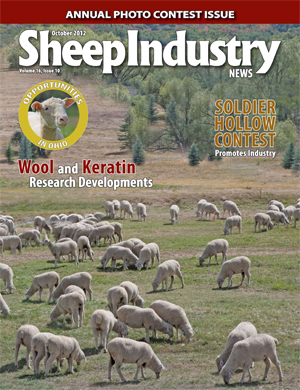Wool and Keratin Research at the ERRC
By AMY TRINIDAD
Sheep Industry News Editor
(Oct. 1, 2012) Throughout the past decade, the American Sheep Industry Association (ASI) has been fortunate to work with the U.S. Department of Agriculture’s (USDA), Eastern Regional Research Center (ERRC) on a number of research projects. Jeanette Cardamone, Ph.D., lead scientist in wool and keratin for wool research, addressed the American Wool Council at the industry-wide convention last January, stating, “We are working to find more ways to add value to wool and we currently have two patents for this; one is a process for bleaching, biopolishing and shrink-proofing wool, the other is for flame-retardant wool.” Since January, the ERRC team has found additional ways in which to add value to wool with good news to report.
Wool Research
As a result of the research conducted at the ERRC, with steady support and funding from ASI in the early stages of development, products such as washable and flame-resistant wool have been developed. Researchers at the ERRC lab developed and patented an environmentally friendly and economical wool-processing method to prevent shrinkage by biopolishing wool. This process has become fully commercialized and is being used by National Spinning Co. Inc., a supplier of spun yarns.
By applying it to yarn, Cardamone says, “It eliminates all the problems our mill people have been having in the past when applying the process to fabric.”
She further explains that in the past, researchers have found applying biopolishing to fabric to be problematic because the bleaching process causes strength loss when processing fine-gage, single jersey knit fabric for military underwear. However, by applying it to yarn, National Spinning has been able to adapt the biopolishing procedures and have been very satisfied with the results.
“The biopolished products are performing very well from a shrinking and felting standpoint,” explains Jim Booterbaugh, chief operating officer for National Spinning.
Wool naturally looses strength during the biopolishing process because the scales of the wool fibers are lost. Booterbaugh explains that during the early part of their biopolishing work, they were getting the desired outcomes in terms of shrinkage; however, they were losing yarn strength.
“After fine-tuning the process, we have gotten the best of both worlds,” he says. “We have found the equilibrium point between the benefits of biopolishing and only losing 7-10 percent of the fiber’s strength.”
This process tends to work better on heavier yarns, Booterbaugh explains. Through the trials at National Spinning, they have found that when applying biopolishing to finer-count yarns, the loss in strength becomes high enough to cause performance problems. Therefore, National Spinning gears their biopolishing work more toward heavier yarns with heavier end-use products such as socks and heavy sweaters. Currently, 5 percent to 10 percent of the wool yarns developed at National Spinning goes through the biopolishing process.
Keratin Research
Another exciting project for Cardamone with great potential involves extracting keratin from wool. Keratin is a protein used in many cosmetic and pharmaceutical products with benefits for human hair, nails and skin. Wool is a source of pure keratin found in up to 93 percent by weight of fiber.
“Keratin is a very important product right now especially for the personal-care industry,” Cardamone explains, stating that ERRC has three patent applications for keratin, each having their own defined beneficial effects for a particular purpose in personal care.
Researchers have been making keratin products in various forms, such as films, gels, emollients, creams, powders, filament strands and sponges. They have determined that no matter how the keratin is applied, it has a natural cohesion to hair, skin and nails providing strengthening, shine and conditioning. One stand-alone keratin product the researchers are particularly excited about is a cream for silicone replacement in cosmetic formulations and biomedical and pharmaceutical applications.
“All these things that are happening in our lab have great potential,” Cardamone says. “Even though we have stand-alone keratin products, we can incorporate ingredients – some might even be eatable like olive oil – to control the consistency of our product. We can then make products that may be acceptable to people who want to have a replacement for petroleum products.”
In order to get the keratin, wool must be made into a liquid form and the ERRC researchers have a number of ways to achieve that. They are applying three hydrolysis methods to wool to extract keratin of three different chemical compositions.
“We are paying strict attention to applying the ARS process in any way we see appropriate,” states Cardamone, further explaining, “I even have someone who wants to apply keratin to paper. They want to use the ARS process to bleach it and strengthen it with keratin. So I think these two technologies –biopolishing and applying the keratin – are now looking like they are converging and they might be headed in a direction where they can benefit each other.”
The increased use of keratin in the personal-care industry can be of great benefit to the wool industry. Even wool that is coarse and doesn’t have a high value in the processing sector can still be developed into a high-end product as the quality of the fiber itself is no issue for trying to develop the keratin technology. Cardamone says she is happy to be conducting this keratin research as there is a commercial company that is supplying keratin at a very high price under their trademark.
“The wool industry appreciates the focus and wool expertise of the ERRC wool lab. Innovations such as these can change an industry,” says Rita Kourlis Samuelson, director of wool marketing at ASI. “Having various avenues in which to market wool products is key to a strong market and we thank ERRC and Dr. Cardamone for their wool research efforts. ERRC is the only fiber research lab for wool of this nature in the United States.”


